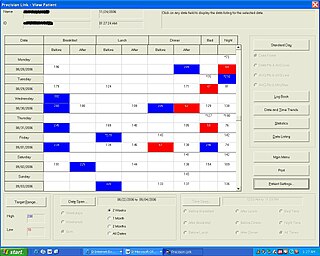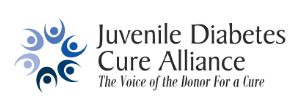
An insulin pump is a medical device used for the administration of insulin in the treatment of diabetes mellitus, also known as continuous subcutaneous insulin therapy. The device configuration may vary depending on design. A traditional pump includes:

Type 1 diabetes (T1D), formerly known as juvenile diabetes, is an autoimmune disease that originates when cells that make insulin are destroyed by the immune system. Insulin is a hormone required for the cells to use blood sugar for energy and it helps regulate glucose levels in the bloodstream. Before treatment this results in high blood sugar levels in the body. The common symptoms of this elevated blood sugar are frequent urination, increased thirst, increased hunger, weight loss, and other serious complications. Additional symptoms may include blurry vision, tiredness, and slow wound healing. Symptoms typically develop over a short period of time, often a matter of weeks if not months.
Inhalable insulin is a powdered form of insulin, delivered with an inhaler into the lungs where it is absorbed. In general inhaled insulins have been more rapidly absorbed than subcutaneous injected insulin, with faster peak concentration in serum and more rapid metabolism.
Automated insulin delivery systems are automated systems designed to assist people with insulin-requiring diabetes, by automatically adjusting insulin delivery in response to blood glucose levels. Currently available systems can only deliver a single hormone—insulin. Other systems currently in development aim to improve on current systems by adding one or more additional hormones that can be delivered as needed, providing something closer to the endocrine functionality of the pancreas.

Diabetes Management Software refers to software tools that run on personal computers and personal digital assistants to help persons with Type 1 and Type 2 diabetes manage the data associated with:

MiniMed Paradigm is a series of insulin pumps manufactured by Medtronic for patients with diabetes mellitus. The pump operates with a single AAA battery and uses a piston-plunger pump to infuse a programmed amount of insulin into the patient through a length of tubing. The Paradigm uses a one-way wireless radio frequency link to receive blood sugar measurements from select glucose meters. The Paradigm RT series adds the ability to receive data from a mated continuous blood-glucose monitor. Although the pump can use these measurements to assist in calculating a dose of insulin, no actual change in insulin delivery occurs without manual user-intervention.
DexCom, Inc. is a company that develops, manufactures, produces, and distributes continuous glucose monitoring (CGM) systems for diabetes management. It operates internationally with headquarters in San Diego, California, and has manufacturing facilities in Mesa, Arizona and Batu Kawan, Malaysia.

Mark Atkinson is an American medical researcher best known for his contributions to research seeking to predict, prevent, and cure type 1 diabetes. He is the author of over 600 publications and is one of the world's most cited diabetes researchers.
Bruce Bode, MD, FACE is a diabetes specialist with the Atlanta Diabetes Associates in Atlanta, GA and is a clinical associate professor at Emory University in the Department of Medicine. He has served on the board of directors of the Atlanta chapters of the Juvenile Diabetes Research Foundation (JDRF), the American Diabetes Association (ADA), and various Georgia-based diabetes camps. Bode is a member of the board of directors of Glytec and an active member of the JDRF research team validating the efficacy and safety of real-time continuous glucose monitoring (CGMS), and is a former president of the ADA Georgia Affiliate and editor of the ADA's 2004 edition of Medical Management of Type 1 Diabetes.
International Diabetes Center at Park Nicollet (IDC) is a center for diabetes care, research and education located in Minneapolis, Minnesota, United States. The center provides clinical, motivational and educational services for people with diabetes. It is part of HealthPartners Institute.
Tandem Diabetes Care is an American medical device manufacturer based in San Diego, California. The company develops medical technologies for the treatment of diabetes and specifically insulin infusion therapy.
Bigfoot Biomedical Inc. is a medical technology start-up headquartered in Milpitas, California, founded by a team of people with personal connections to type 1 and type 2 diabetes.

The Juvenile Diabetes Cure Alliance (JDCA) is a registered 501(c)(3) non-profit organization dedicated to developing a "Practical Cure" for type 1 diabetes. The organization advocates for increasing type 1 diabetes cure research and publishes reports on a variety of related topics, including research progress, fundraising utilization, and donor priorities. Established in 2010, the organization’s home office is in New York City and it focuses primarily on activity within the United States.
Boris Petrov Kovatchev is a professor at the University of Virginia where he is the founding Director of the UVA Center for Diabetes Technology, and a principal investigator of the JDRF Artificial Pancreas Project.
Nightscout is a free and open-source project, and associated social movement, that enables accessing and working with continuous glucose monitor (CGM) data. Nightscout software aims to give users access to their real time blood sugar data by putting this data in the cloud. In addition to browser-based data visualization, Nightscout can also be used to review data from a phone or smartwatch, or to remotely monitor CGM data for individuals with type 1 diabetes. Associated with Nightscout software is a broader "CGM in the Cloud" social movement, supporting individuals seeking to access and use realtime CGM data through commercial and DIY approaches.
The Open Artificial Pancreas System (OpenAPS) project is a free and open-source project that aims to make basic artificial pancreas system (APS) technology available to everyone. The OpenAPS project was designed with the idea of quickly getting the APS technology to more people using a direct approach, rather than waiting for clinical trials to be completed and regulatory approval to be granted.

A continuous glucose monitor (CGM) is a device used for monitoring blood glucose on a continual basis instead of monitoring glucose levels periodically by drawing a drop of blood from a finger. This is known as continuous glucose monitoring. CGMs are used by people who treat their diabetes with insulin, for example people with type 1 diabetes, type 2 diabetes, or other types of diabetes, such as gestational diabetes.
Gerold Grodsky (1927–2022) was an American professor of biochemistry, biophysics, and medicine at the University of California, San Francisco Diabetes Center, as well as a diabetes researcher. He is most known for his contributions to the modern artificial pancreas.
William V. Tamborlane has been Professor and Chief of Pediatric Endocrinology at Yale School of Medicine since 1986.
Robin Koops is a Dutch mechanical engineer, designer and inventor. He is known for developing an artificial pancreas.










